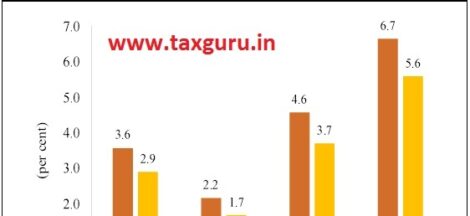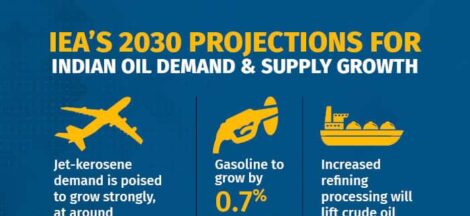NEW DELHI: At a time when the global economy is still facing uncertainties, with growth decelerating in some of the most advanced economies, India’s economy has exhibited resilience and has been able to grow at a rate much higher than market expectations. Key macro-indicators such as consumer price index (CPI) inflation, wholesale price index (WPI) inflation, trade and current account deficit (CAD) are benign, and are expected to remain range-bound in the near-term as well.
In the first three quarters of FY24, the country’s gross domestic product (GDP) expanded sharply by 8.2%, with the growth in Q3 coming in at a six-quarter high of 8.4%. This is way higher than the market consensus of 6.7%. Ofcourse, the base effect helped, but largely the push to growth came from investments.
“The breakdown (of Q3 GDP data) revealed a robust manufacturing push compared to farm output, urban spending outpacing rural demand, and investment growth spurred by frontloading of central and state capital spending, along with households’ capital expenditure,” said Radhika Rao, senior economist, DBS Group Research.
Apart from the Centre’s capital expenditure on railways, roads & highways, defence, and transfer to states, which has been ongoing, the current year has also seen a pickup in residential construction, which has been a backstop for non-corporate private capital expenditure, economists say.
Notably, the share of gross-fixed capital formation (GFCF) – a proxy for investments in the economy – is expected to rise to 34.1% in the GDP in FY24, which will be the highest in the past 11 years. In FY23, the GFCF’s share in GDP was 33.3%.
Perhaps, the sharp rise of GFCF’s share in the GDP, is the reason why the latter has been able to grow at around 5 percentage points (pps) higher than the private consumption growth (PFCE), as witnessed during the December quarter of FY24. Many including former chief statistician Pronab Sen have called this gap “unprecedented” and “inexplicable”. Also, it is seen that while a section of Corporate India may be ramping up capacities, the MSME segment and informal economy isn’t keeping pace. This causes concerns about the durability of the growth revival, if not about the quality of the data itself.
DBS’ Rao says that the trend may continue in the next fiscal year as well. “FY25 is expected to mark the fourth consecutive year where the rate of investment growth outpaces consumption, revisiting the streak observed in 2004-2008,” she said.
Inflationary pressures largely have remained contained, with the headline retail inflation print staying below the 6% mark in nine of the first eleven months. So far, in April-February, CPI inflation has averaged 5.4%, much lower than 6.8% average in April-February of FY23.
Core CPI inflation, which excludes food and fuel components, is currently at a 12-year low of 3.3%, but food inflation is high, and is expected to determine the trajectory of headline CPI rate going forward.
“Inflation is on the ebb; the steady decline in core inflation would have taken down headline inflation towards the target of 4% even sooner and faster, but for the repetitive incidence of short amplitude food price pressures,” said RBI staff in a recent paper. “The CPI readings for January and February 2024 show that the winter easing of vegetable prices turned out to be shallow and short-lived,” the staff said.
Food prices in the current fiscal year were heavily impacted by the El Nino phenomenon. According to a report by HDFC Asset Management, the El Niño that we are currently witnessing is one of the strongest on record, which has also resulted in 2023 being the hottest year. “This phenomenon is called ‘Super El Nino’, and is just the sixth time since measurements began in 1950,” the report said.
But forecasts for the coming months suggest that its effects are slowly weakening and are expected to reverse, perhaps before the monsoon onset, leading to improved rainfall conditions for India. “Such reversal in weather patterns could bode well for consumption, as it boosts rural incomes and lowers inflation expectations,” the report said.
WPI inflation has also remained starkly low this year, in the backdrop of depressed commodity prices. The manufactured products’ group, within WPI, has remained in the deflation zone in all months of the current fiscal and is seen to remain low in the near-term too. Since the group reflects input price pressures, a negative print means that there is no immediate threat of pass-through to retail prices and subsequently to core CPI inflation.
Meanwhile, the country’s CAD has shrunk sharply in the first three quarters of FY24, and is expected to shrink even more in the March quarter. So far, in April-December, the CAD has narrowed to 1.2% of GDP from 2.6% in the comparable period of FY23.
The moderation has been primarily aided by the record services trade surplus, which has sharply pulled down the overall trade deficit to merely $2.7 billion in April-February FY24. For comparison, India’s overall trade deficit was $114.5 billion in April-February FY23. Economists have projected the full year’s CAD to be well below 1% of the GDP.
A lower CAD also helped in controlling the depreciation of the rupee against the dollar. The rupee concluded FY24 with a 1.5% decrease against the US dollar, a significant improvement compared to the nearly 8% decline seen in FY23. Despite challenges such as rising oil prices and a stronger dollar, the local currency performed relatively well when compared to other emerging market currencies. On March 28, the rupee closed at 83.40-a-dollar.
In the next fiscal, rupee will be range bound and based on fundamentals and external forces will range between 82.50-83.50/USD, said Madan Sabnavis, chief economist, Bank of Baroda. “A lower CAD and higher FPI (foreign portfolio investments) will improve fundamentals,” he said.
In FY25, economists expect consumption to pick-up from easing inflation, rate reductions to take place, improvement in sentiments, and growth in real wages. “Overall, strength in domestic demand will be crucial, including a lift in private capital spending as well as early benefits from the manufacturing push, which will help to offset exogenous headwinds,” said DBS’ Rao. Most economists expect FY25 GDP growth to be around 7% or slightly higher.
(Source: The Financial Express



